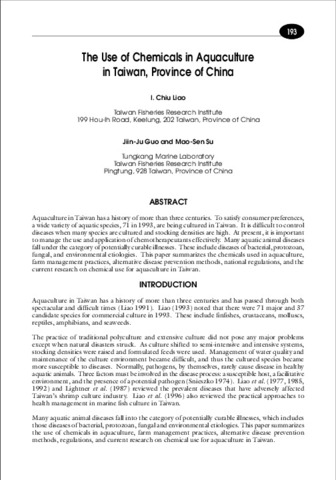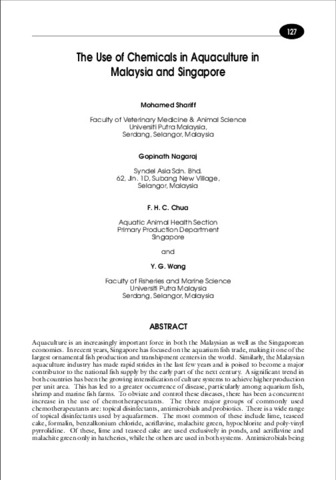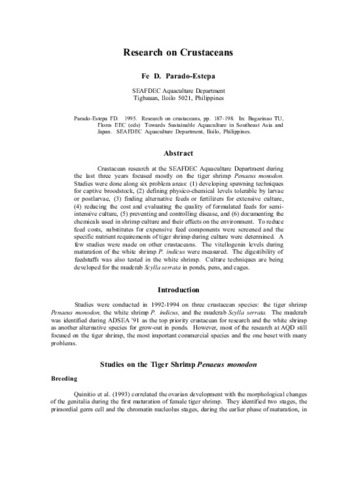The use of chemicals in aquaculture in Taiwan, Province of China
- Global styles
- MLA
- Vancouver
- Elsevier - Harvard
- APA
- Help

Date
2000Page views
6,723ASFA keyword
stocking density 
anaesthetics
protozoal infections
disease control
potassium compounds
antibiotics
aquaculture
environmental factors
aetiology
feed composition
disinfectants
fertilizers
consumers
copper compounds
bactericides
fungal diseases
drugs
ammonium compounds
ichthyocides
chlorine compounds
aquaculture regulations
husbandry diseases
bacterial diseases
saponins
salts
iodine compounds
dyes
fish diseases
fungicides
pesticides
disease prophylaxis
quinolines
animal diseases

anaesthetics

protozoal infections

disease control

potassium compounds

antibiotics

aquaculture

environmental factors

aetiology

feed composition

disinfectants

fertilizers

consumers

copper compounds

bactericides

fungal diseases

drugs

ammonium compounds

ichthyocides

chlorine compounds

aquaculture regulations

husbandry diseases

bacterial diseases

saponins

salts

iodine compounds

dyes

fish diseases

fungicides

pesticides

disease prophylaxis

quinolines

animal diseases

AGROVOC keyword
Metadata
Show full item record
Share
Abstract
Aquaculture in Taiwan has a history of more than three centuries. To satisfy consumer preferences, a wide variety of aquatic species, 71 in 1993, are being cultured in Taiwan. It is difficult to control diseases when many species are cultured and stocking densities are high. At present, it is important to manage the use and application of chemotherapeutants effectively. Many aquatic animal diseases fall under the category of potentially curable illnesses. These include diseases of bacterial, protozoan, fungal, and environmental etiologies. This paper summarizes the chemicals used in aquaculture, farm management practices, alternative disease prevention methods, national regulations, and the current research on chemical use for aquaculture in Taiwan.
Suggested Citation
Liao, I. C., Guo, J. J., & Su, M. (2000). The use of chemicals in aquaculture in Taiwan, Province of China. In J. R. Arthur, C. R. Lavilla-Pitogo, & R. P. Subasinghe (Eds.), Use of Chemicals in Aquaculture in Asia: Proceedings of the Meeting on the Use of Chemicals in Aquaculture in Asia, 20-22 May 1996, Tigbauan, Iloilo, Philippines (pp. 193-205). Tigbauan, Iloilo, Philippines: Aquaculture Department, Southeast Asian Fisheries Development Center.
Type
Conference paperISBN
9718511490Collections
Related items
Showing items related by title, author, creator and subject.
-
The use of chemicals in aquaculture in Malaysia and Singapore
Mohamed, Shariff; Nagaraj, Gopinath; Chua, F. H. C.; Wang, Y. G. (Aquaculture Department, Southeast Asian Fisheries Development Center, 2000)Aquaculture is an increasingly important force in both the Malaysian as well as the Singaporean economies. In recent years, Singapore has focused on the aquarium fish trade, making it one of the largest ornamental fish ... -
Research on crustaceans
Parado-Estepa, Fe D. (Aquaculture Department, Southeast Asian Fisheries Development Center, 1995)Crustacean research at the SEAFDEC Aquaculture Department during the last three years focused mostly on the tiger shrimp Penaeus monodon. Studies were done along six problem areas: (1) developing spawning techniques for ... -
Artificial substratum consisting of poly-β-hydroxybutyrate-based biodegradable plastic improved the survival and overall performance of postlarval tiger shrimp Penaeus monodon
Ludevese-Pascual, Gladys ; Laranja, Joseph Leopoldo
; Laranja, Joseph Leopoldo  ; Amar, Edgar
; Amar, Edgar  ; Bossier, Peter; De Schryver, Peter (Wiley, 2019)
The use of artificial substratum consisting of poly‐β‐hydroxybutyrate (PHB)‐based biodegradable plastic for penaeid shrimp culture was investigated in the present study. The survival of postlarval tiger shrimp Penaeus ...
; Bossier, Peter; De Schryver, Peter (Wiley, 2019)
The use of artificial substratum consisting of poly‐β‐hydroxybutyrate (PHB)‐based biodegradable plastic for penaeid shrimp culture was investigated in the present study. The survival of postlarval tiger shrimp Penaeus ...




